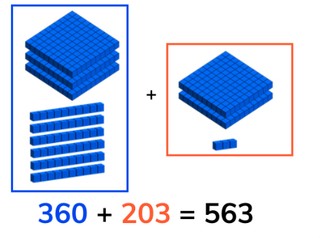
Addition to 1,000 without crossing tens or hundreds
Add to 1,000 without crossing tens or hundreds.



8,000 schools use Gynzy
92,000 teachers use Gynzy
1,600,000 students use Gynzy
General
Add numbers to 1,000 without crossing tens or hundreds.
Standards
CCSS.Math.Content.2.NBT.B.7
Learning objective
Students will be able to add up to 1,000, without crossing tens or hundreds.
Introduction
Show a few addition problems on the interactive whiteboard whose answers have been covered with the paint splatters. Ask students to solve the problems and reveal the answers by erasing the paint splatters.
Development
Tell students that they can add by counting on. You start by counting how many you already have, that is the first number in the addition problem. Then you count how many are added, that is the second number in the addition problem. When you add these two numbers together, you find the sum or total. Show this on the interactive whiteboard using the blocks, and discuss the different math problems that you show. Check that students are able to do so by asking them to add the blocks and money together individually or in pairs. Next remind students that they can solve addition problems in different ways. You can use a number line to count on, you can add the hundreds and tens separately, and then add those two totals together. Have students practice a few methods individually. Ask students to explain their strategy in solving the problem. Finally show students how to solve a story problem. Remind them that they first determine what kind of math problem it is, they find the numbers important to the math problem, then they say or write the math problem, and finally they solve the math problem. Practice one story problem together and then ask students to solve a story problem individually or in pairs, following the steps given.
Check that students are able to add numbers to 1,000 by asking the following questions:
- How do you solve 103 + 386?
- How do you solve 462 + 413?
Guided Practice
Students practice by adding two numbers to 1,000 without crossing tens or hundreds with visual support. Then they are only given the problem and asked to solve. Finally students are given story problems to solve.
Closing
Discuss with students that it is important to be able to add to 1,000 so that you can determine totals of large numbers. Show the MAB blocks on the interactive whiteboard and ask students to match the problem and then solve the problem. Next give an abstract problem to solve and end with a story problem. Ask students to explain their strategy for solving the addition problems. Close by showing the two items for sale and asking students to determine how much they would need to pay in total to buy both objects.
Teaching tips
Students who have difficulty with this learning goal can be supported by the use of a number line. Remind students that they can take jumps in different quantities on the number line (1, 2, 5, etc). They can also make use of a sheet of scratch paper to help solve the addition problem.
Instruction materials
Optional: MAB blocks or other manipulatives
The online teaching platform for interactive whiteboards and displays in schools
Save time building lessons
Manage the classroom more efficiently
Increase student engagement
Discover more!
About Gynzy
Gynzy is an online teaching platform for interactive whiteboards and displays in schools.
With a focus on elementary education, Gynzy’s Whiteboard, digital tools, and activities make it easy for teachers to save time building lessons, increase student engagement, and make classroom management more efficient.



